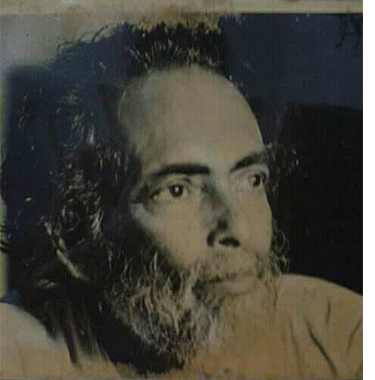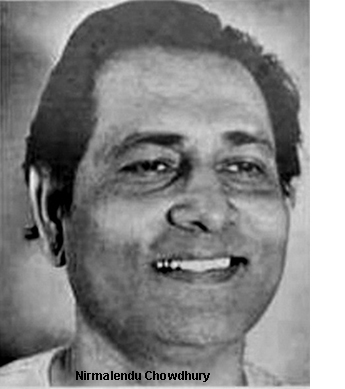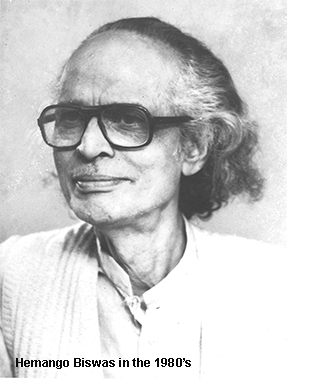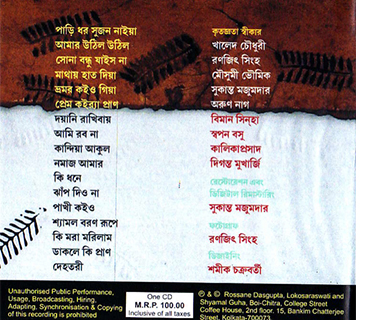
A BOATMAN NAMED RANEN ROYCHOWDHURY
When the 25-year-old Ranen Roychowdhury came to Calcutta from Sylhet, he carried in the vessel of his body, songs from a home he had to leave behind. But this was not just generic communal music that he brought with him, this was also a music processed inside the artist, something of his own… something which was born of his individual experence and sensitivity.
Majhi tor naam jani na
Ami daak dimu kare?
Boatman, I don’t know your name.
Who shall I call?
Ranendra Ballav Roychowdhury (1925-85), popularly known as Ranen Roychowdhury, was born in Tantikona village of the Chhatok region of Sylhet into a land-owning family, also engaged in the arts; his elder brother was a painter. He grew up in Sylhet, and came to Calcutta after Partition, in 1950. Those were politically difficult and heady times for a nation newly broken and nations newly born. His friends were the Communists, he too was a member of the Party and also active in the Indian People’s Theatre Association. He had learned to sing songs in the mystic tradition of the fakirs and bauls, from the itinerant and ‘sadhak’ singers he met at the shrine of Hazrat Shah Jalal in Sylhet, and whose close company he kept.
Read Khaled Chowdhury’s ‘Nihshabde Chole Gelen Ranen Roychowdhury’, a memoir in Bengali, included in Ranen Roychowdhuryr Gaaner Bhuban. (Kolkata: Boi-Chitro and Lok Saraswati, 2009), pp.13-17.
Here is a link to download a pdf file of the essay.
Also, listen to Khaled Choudhury’s introduction to Sheikh Bhanu’s composition ‘Nishithe jaiyo phulobone’, sung by Ranen Roychowdhury– https://www.youtube.com/watch?v=AMD3gdyoLu8 (accessed, 29 July 2018).
Heartbroken, I weep by the shore of this life,
Who, pray, will take me across?
Boatman, I don’t know your name.
Who shall I call?
Majhi tor naam jani na
Ami daak dimu kare?
This song of Idom Shah holds an iconic place in the cultural history of post-Parition Bengal. It was used by Ritwik Ghatak in his film Meghe Dhaka Tara (The Cloud-Capped Star, 1960); a film about the struggles, dreams and death of dreams of a family and a people uprooted from their home in East Bengal by Partition in 1947, seeking to make a new home in Calcutta. Ghatak (1925-76) was deeply affected by the historical event of Partition, his heart was broken, and his entire ouvre was an attempt to ask the question of what will our lives be henceforth?

The body as the vessel which makes possible this crossing of the song, across borders of time and space, was very important in the case of Ranen Roychowdhury. In all the fond remembrances and critical assessments of his friends and admirers after his passing in 1985, from his elder brother’s friend and later co-worker at the Folk Music and Folklore Research Institute, Khaled Choudhury, who was himself an artist and song collector and musicologist, to his student and the well-known folk singer Swapan Basu, to his friend, the writer Ashish Lahiri, everyone talked about the peculiarity of his gestures, his immersive manner, the deep lost look in his eyes, the pain in his voice. There was something other-worldly about him, seemed to be the general consensus.
‘One day, I remember, we were in the inner chambers of Kathashilpa [publishers], raking up a storm over whether the state was semi or a quarter-feudal or whether we were living under comprador-bourgeoisie, when Ranenda made an appearance. His voice could be heard from the distance, even before he actually arrived. Amar kalo pakhi ure gelo bhalobashar shikol chhnire (My black bird has flown away, breaking free from its chains of love). Someone hastily got up and offered him a seat. Ranenda sang on, with his misty eyes looking into some space beyond. He sang the whole song, stood up, then left without speaking a word.
After a minute or so the spell broke and Montuda said, you know what? He had come to say something and this was his way.’
The original in Bangla can be found in Ashish Lahiri’s essay, ‘Montudar Smriti’, included in his book, Sanskritir Bangla Bazar (Bengali), (Kolkata: Ritakshar, 2012), p. 88-89. Read the pages here.
Interestingly, it was this intensely private voice which came to hold a community’s grief in the films of Ritwik Ghatak; the grief of a people who had lost their homeland to the Partition of Bengal. Perhaps it was in that lone voice that Ghatak heard the sound of the aloneness of the refugee, plucked from their community and thrown into the deep and turbulent waters of Calcutta, with no boatman to row them across.
Ghatak and Roychowdhury shared a special bond, about which the latter wrote after Ghatak’s death in 1976. ‘It was on a cold day in the Bengali month of Kartik (which would be some time between mid October and November) when Ranen Roychowdhury had gone to meet Ghatak for the first time, in a film studio. He was wearing a thin shirt and did not want to be late, because he had a recording for All India Radio the next day and could not risk being ill. But Ghatak kept him on hold and listened to song after song and with each song he sang, the impassioned director said, I want this one too.’
Ranen Roychowdhury’s tribute was called ‘Je Manushtir Naam Ritwik Ghatak’, and it was included in Ranen Roychowdhuryr Gaaner Bhuban. (Kolkata: Boi-Chitro and Lok Saraswati, 2009), pp.66-68.
Read the eassay here.
What did Ghatak hear in Ranen Roychowdhury’s songs? According to Khaled Choudhury, ‘Ritwik Ghatak loved Ranen very much. Those who had to leave their desh because of Partition nurtured a sense of emptiness and intense longing for that lost homeland. Ritwik felt this way too. And it seems that he found a certain refuge in the original and untampered folk tunes of East Bengal of Ranen.’
He wrote this in that same essay, ‘Nihshabde Chole Gelen Ranen Roychowdhury’.
Read here.
Then Khaled Choudhury goes on to elaborate on this ‘untampered’ purity of Ranen Roychowdhury: how he was the real and true voice of rural East Bengal and how definitive his ‘Marifati’ (Sufi spiritual) songs were. He also writes about the wealth of songs Ranen Roychowdhury had brought with him from Sylhet—songs representative of communal life, such as women’s songs, ritual songs, work songs and so on. Ranen therefore becomes both the generic and the individual for us.
It strikes me now, how in the 1950s, three prominent voices had come out of Sylhet and burst upon the cultural scene of Calcutta, soon after the violent breakup of Bengal, and how distinctly different they were from one another! If at one end of the spectrum was Ranen Roychowdhury, part of the Left cultural movement, essentially private as an artist, carried to his niche audience by the films of Ritwik Ghatak; then at the other end was Nirmalendu Chowdhury, the mellifluous voice of radio and gramophone records, whose sound and style were accessible, hence popular; even commercially successful.
Recently (on 2 July 2018) I had a very interesting conversation with Amulya Kumar, or Amulya Kaka, as we call him, the singer of jhumur from Joypur, Purulia, whom we have been recording since 2005. We were talking about how he got connected with Kolkata and he said his first encounter with the city was probably through the folk singer Nirmalendu Chowdhury, who was in Joypur many years ago and wanted to ‘pick up’ some songs of the region. A local doctor, probably a relative of Nirmalendu’s, asked Kaka to come and meet the singer. Amulya Kaka went and sang a few songs, one of which was ‘Jhinga phule dhorol koli’. Nirmalendu liked it very much. He recorded Kaka’s song on a tape recorder. Later he sang it on the radio and also recorded it, but Nirmalendu’s version was quite transformed from Kaka’s.

Here is Amulya Kaka’s story. song
And here is Nirmalendu’s ‘Jhinga phul’.
https://www.youtube.com/watch?v=Te2Zn0lf_Ig
This here is a famous ‘bhatiyali’ of Nirmalendu, stripped of most of its Sylhetiness.
https://www.youtube.com/watch?v=O99EgRyVQoE
Between Ranen Roychowdhury and Nirmalendu Chowdhury was the earnest and compelling voice of Hemango Biswas, the Leftist activist-artist, music teacher, leader of a cultural group which performed folk and protest songs, also a writer and music theorist.
One of the first songs of Hemango Biswas that I had ever heard was ‘Dehotori’, a song which also uses the metaphor of the river and sailing.

Dehotori dilam chhari
O guru tomari naame.
I set sail my boat in your name, o guru,
Should I sink, the blame is all yours.
Here is Hemango Biswas singing Dehotori.
https://www.youtube.com/watch?v=AmULE_uK1qY (accessed 29 July 2018)
Hemango Biswas’ daughter Rongili, a singer, writer and music researcher, has been putting together an archive of her father’s work and in it you get a sense of not just his work, but also of the time him and Ranen Roychowdhury and all these other artists who are part of our story, inhabited. A time they all created too. Like us, Rongili’s work has been supported by India Foundation for the Arts. (http://www.indiaifa.org/grants-projects/rongili-biswas.html, accessed 29 July 2018).
Here are some more YouTube links to Hemango Biswas’ songs and discussions on his music. (accessed 29 July 2018)
http://humanitiesunderground.org/singing-the-boatman-hemango-biswas-and-the-bahirana-in-folk-music/
https://www.youtube.com/watch?v=w9TMNHsxjAU&t=21s
https://www.youtube.com/watch?v=HEmUueB_JhA
Listening to the unique and inimitable Ranen Roychowdhury, we think, did his songs spring purely from his artistic self, without any communal antecedent? Was he not part of any continuity? Are we all not part of some continuity? Ranen Roychowdhury did not like to teach, as the folk singer Swapan Basu writes, and he did not much like to perform either.
Swapan Basu’s essay ‘Gurushishya Parampara’, is also in Ranen Roychowdhuryr Gaaner Bhuban. (Kolkata: Boi-Chitro and Lok Saraswati, 2009), pp.25-31
Read the eassay here.
Swapan Basu on YouTube. Accessed 29 July 2018.
https://www.youtube.com/watch?v=qePJ7njtdmY
https://www.youtube.com/watch?v=UDxCed0bEPE
In fact, although Swapan Basu learned many songs from him, he came out with quite a distinct style of his own, marked by his own place and time and also the demands of the media for which was mostly performing, namely popular television and the cassette industry. Roychowdhury’s younger daughter, Sanchita, a singer in her own right, is probably the only person who sings somewhat like him, clinging to his song like she will not let him go. She did not directly learn that many songs from her father when he was alive, but his music fills the space of her home and her head even now. In an interview given to The Travelling Archive in 2009, she described how her father would wake up every morning at 4 am and make a flask of tea and smoke endless bidis and sing song after song.
After her father’s death in 1985, Sanchita gradually began to get into the songs of Sylhet, but only through the listening she associated with her father. She listened for the song that had travelled through time and space to come to her. For her it was important to sing the way she did, because in so doing, she could protect, preserve and perpetuate Ranen Roychowdhury’s song.
In 2009, Sanchita had brought to Sukanta a set of home recordings of her father made on audio cassettes at different times, gathered from friends and acquaintances, because their family and Lok Saraswati now wanted to release an album of his songs, the first time ever. Sukanta worked on the recordings and cleaned and digitally remastered them and here is a selection from that album. They called it Pari Dhoro Sujano Naiya, ‘Hold the helm O good boatman’. A sujan naiya or good boatman he was for sure; a man whose songs have helped us ride many a rough sea on many a lonely night.

Written by Moushumi. Essay in text, image and sound created by Sukanta. 30 July 2018.
Source: Photos and songs of Ranen Roychowdhury, from his family. The photo on the header was taken during an AIR recording in the 1960s. The other main one is from 1984.
Hemango Biswas and Nirmalendu Chowdhury’s photos are taken from the Internet, but we could not trace their source.
The extracts from Ranen Roychowdhuryr Gaaner Bhuban have been uploaded with permission from Buddhadeb Samaddar of Lok Saraswati. Ashish Lahiri has kindly given us permission to upload an extract from his essay ‘Montudar Smriti’.
